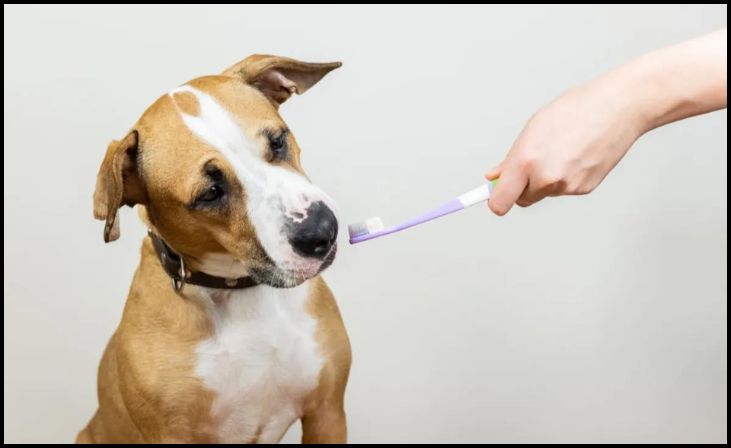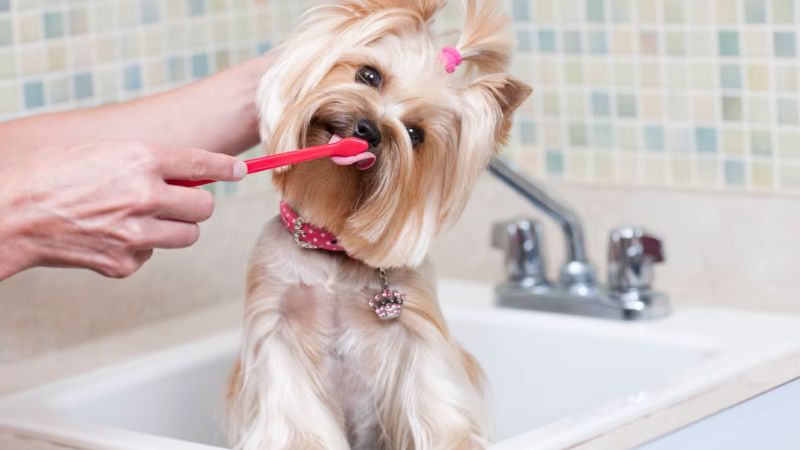Good dental hygiene is essential for the overall health and well-being of your canines. Dogs and cats are susceptible to dental issues that can affect their quality of life, much like humans. Without regular maintenance, plaque buildup can lead to gum disease and potentially severe conditions like tooth decay and oral infections. These problems not only cause discomfort but can also affect your pet’s ability to eat, play, and enjoy life to the fullest. By prioritizing good oral hygiene, you can significantly reduce the risk of these issues and ensure that your pets maintain strong, healthy teeth and gums throughout their lives.
Dental Care 9 Tips For Dogs And Cats
Regular Brushing
Regular brushing is the cornerstone of good dental hygiene for pets. Using a toothbrush and toothpaste specifically formulated for animals is crucial, as human toothpaste contains ingredients like fluoride that can be toxic if swallowed by pets. Start the brushing process slowly, especially if your pet is not accustomed to it. Begin when they are young to familiarize them with the routine and make it a positive experience. Use gentle circular motions, focusing on the outer surfaces of the teeth and along the gum line where plaque tends to accumulate.

Dietary Considerations
Your pet’s dental health is significantly influenced by their diet. Choose dental-friendly foods and treats that are designed to promote oral hygiene. Look for products approved by veterinary dentists, which often contain ingredients such as enzymes that help break down plaque and prevent tartar buildup. Dental chews or treats with textures that encourage chewing can mechanically clean teeth and massage gums while your pet enjoys them.
Read Also: 9 Best Practices For Training With Dogs
Chew Toys
Dental chew toys are invaluable for maintaining your pet’s oral health. These toys are designed to be durable and provide a textured surface that helps clean teeth as your pet chews. Choose toys appropriate for your pet’s size and chewing habits to prevent choking or dental damage. Some dental chews are infused with ingredients like chlorophyll or enzymes to further aid in plaque reduction and freshen breath. Introduce new chew toys gradually and monitor your pet’s interaction with them to ensure safety and effectiveness.
Annual Vet Visits
Regular veterinary check-ups are essential for monitoring and maintaining your pet’s dental health. During these visits, your veterinarian will conduct a thorough oral examination, checking for signs of dental disease such as inflamed gums, tartar buildup, or loose teeth. Professional dental cleanings performed under anesthesia are often recommended to remove plaque and tartar that brushing alone cannot address. These cleanings help prevent periodontal disease, which can lead to pain, tooth loss, and systemic health issues if left untreated.

Monitor Oral Health
In addition to veterinary visits, regularly monitor your pet’s oral health at home. Get into the habit of inspecting their mouth and teeth weekly, looking for signs of dental problems such as bad breath, swollen gums, yellow or brown tartar buildup on teeth, or changes in eating habits. Gently lift your pet’s lips to examine their gums and teeth, checking for any abnormalities or signs of discomfort.
Avoid Human Products
It’s crucial to use only products specifically formulated for pets during their dental care routine. Human toothpaste contains ingredients like xylitol, fluoride, and foaming agents that can be harmful or toxic to pets if ingested. Pet-safe toothpaste comes in flavors like poultry or malt, appealing to pets and making brushing more enjoyable. Choose a soft-bristled toothbrush or finger brush designed for pets, as these are gentle on their gums and teeth.
Brushing Technique
When brushing your pet’s teeth, approach the process with patience and a calm demeanor. Start by gently introducing the toothbrush or finger brush, allowing your pet to sniff and lick the toothpaste to get used to the taste and texture. Begin brushing with slow, circular motions, focusing on the outer surfaces of the teeth and along the gum line where plaque tends to accumulate. Gradually increase the duration of brushing sessions as your pet becomes more comfortable, aiming for at least 2 minutes per session.

Water Additives
Dental water additives can be a convenient addition to your pet’s oral care regimen. These products are designed to be added to your pet’s drinking water, where they work to disrupt plaque formation and freshen breath between brushings. Dental water additives often contain ingredients like enzymes or antimicrobial agents that help maintain oral hygiene and reduce the risk of dental disease. Follow the manufacturer’s instructions for dosing and frequency when adding dental water additives to your pet’s water bowl.
Read Also: Deciding On The Appropriate 9-Dog Breed For Your Lifestyle
Behavioral Reinforcement
Making dental care a positive experience for your pet is essential for long-term success. Use positive reinforcement techniques such as praise, treats, or favorite toys to reward your pet after each brushing session. Create a calm and comfortable environment for brushing, and establish a consistent routine that your pet can anticipate and participate in willingly. Be patient and supportive, especially if your pet is initially hesitant or resistant to dental care.
Conclusion
Maintaining good dental hygiene for your dogs and cats is essential for their overall health and longevity. By following these tips and being proactive about their oral care, you can help prevent dental problems and ensure your pets have healthy smiles for years to come. Regular veterinary check-ups and a consistent dental care routine at home are key to keeping your pets’ teeth and gums in top shape.
Frequently Asked Questions (FAQs)
How often should I brush my pet’s teeth?
It’s ideal to brush your pet’s teeth at least 2-3 times a week, if not daily. Starting a dental care routine early in your pet’s life can make them more comfortable with regular brushing.
What should I do if my pet resists brushing?
If your pet is resistant to brushing, start slow and use positive reinforcement. Gradually introduce the toothbrush and toothpaste, and be patient. If needed, consult with your veterinarian for additional tips.
Are there signs that indicate my pet may have dental issues?
Yes, watch out for signs such as bad breath, swollen or bleeding gums, difficulty chewing, drooling, or reluctance to eat. If you notice any of these symptoms, schedule a veterinary dental exam promptly.



